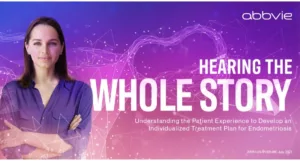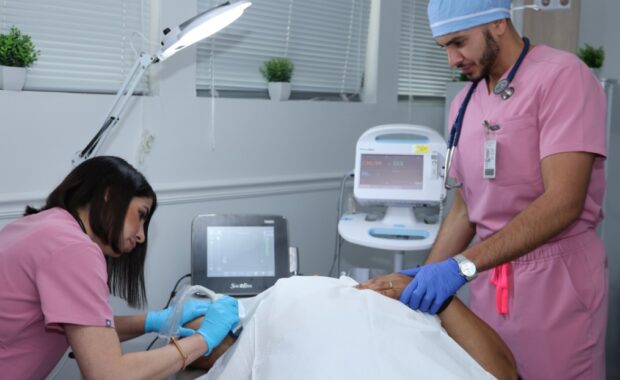You Can Make a Difference in Endometriosis Care
September 6, 2023
SPONSORED

Endometriosis has gained traction in the media and social media, as affected individuals and groups are raising awareness about its impact while helping to dispel misconceptions and myths about the disease.
As a common, chronic disease with potentially profound effects on the overall well-being of a patient,1,2 there is a need for earlier recognition and understanding of endometriosis, as well as effective management.1,2
Since PAs are often at the frontline of care,3 there is a remarkable opportunity for PAs to make a difference. PAs are crucial for healthcare delivery in the United States, practicing and advancing patient care in all specialties, including women’s health.3 PAs providing routine care to premenopausal women, are very likely to encounter patients with chronic pelvic pain which can be caused by a wide array of diseases, including endometriosis.1 With an estimated prevalence of 4.1 million women of reproductive age in the United States,4 and a high occurrence of endometriosis in women with chronic pelvic pain,4,5 primary care providers may often be the first point of contact for patients with endometriosis symptoms.6 A patient-centered approach can empower PAs to recognize the most common symptoms associated with endometriosis and begin management.
Endometriosis is an individual experience. Beyond pain symptoms (which will be described below), endometriosis can significantly impact daily life activities, mental and physical health, productivity, personal relationships, and sexual function.7-9
Characterized by the New York Times as “a debilitating illness, often ignored,”10 the endometriosis journey is complicated by a diagnostic delay for many patients, ranging from 4 to 11 years. 9,11-17 As endometriosis-associated manifestations tend to overlap with those of other organ systems (i.e., urinary and gastrointestinal systems),1,17 patients often see multiple providers to address specific symptoms.16,18 Normalization of symptoms by the provider and patient are other factors that contribute to diagnostic delays.17,18
Understanding the systemic nature of endometriosis and its symptomology sets the foundation for identifying patients that may have the disease.1 As researchers learn more about endometriosis, its definition and scope have evolved to account for its extra-pelvic manifestations. Hence, a strong awareness of the systemic effects of endometriosis can help us comprehend its full extent.1
The most common types of pelvic pain associated with endometriosis include dysmenorrhea (pain during menstruation), nonmenstrual pelvic pain (pain outside of menstruation), and dyspareunia (pain during sexual intercourse). Specifically, the disease is characterized by chronic, cyclic pelvic pain that can be progressive.1,2,6,11,19
Other reported manifestations include dyschezia (pain with defecation) and dysuria (pain with urination).17 Additionally, up to 50% of patients with endometriosis experience infertility.20,21 Neurological features such as depression and anxiety are also common.22
The clinical presentation of endometriosis is varied.1 Consider that both of the following patients have a clinical picture suggestive of endometriosis—a 35-year-old woman with progressive dysmenorrhea, dyspareunia, and dyschezia, and a 24-year-old with a history of dysmenorrhea in adolescence who is experiencing progressive dysmenorrhea and nonmenstrual pelvic pain. Also, note that patients with endometriosis may present for infertility but have no pain symptoms.6
The path to diagnosis has traditionally been a surgical one; however, key opinion leaders in endometriosis have proposed a shift in current practice toward clinical diagnosis.1,2 This contemporary diagnostic approach is comprised of careful history-taking, physical examination, and imaging.1,2
Diagnosing endometriosis can be challenging, especially for clinicians who are less familiar with the characteristics of endometriosis-associated pain and widespread symptoms that can occur with this disease.1 Case in point, the symptomology of the patients described above should raise suspicion for endometriosis; however, pain symptoms are also common to other gynecologic conditions and symptoms related to bowel and bladder can present with nongynecologic diseases.1 Hence, the presence of cyclic, progressive pelvic pain can help differentiate endometriosis from other conditions and rule out other causes of pelvic pain.1,6,11,19 Additionally, deep dyspareunia, infertility, and bowel and bladder symptoms may also contribute to the overall clinical picture.1,17,20,21
Further relevant information pertains to the patient’s body mass index (typically low), mood disorder, fatigue, family history of endometriosis, and adolescence history related to dysmenorrhea and school absence. A thorough history should also include associated comorbidities such as migraines and autoimmune diseases.1,2
Other components of a clinical-based diagnosis include physical examination and imaging.1,2 Potential examination findings may include but are not limited to tender nodules along the uterosacral ligaments, palpable nodules on rectovaginal examination, and adnexal mass (i.e., endometrioma), although patients with endometriosis may have a normal examination.1,2 As for imaging, transvaginal ultrasound and pelvic MRI can evaluate for the presence of endometriomas, adenomyosis (which can frequently coexist with endometriosis), uterine fibroids, or other adnexal masses.1 It is important to emphasize that negative findings on physical examination and imaging do not rule out endometriosis.1,2,23 Imaging can, however, exclude other etiologies of pain.1,2
Partnering with a patient can encourage them to communicate more openly about their journey.24,25 As patient-centered care is paramount, listening to patients and understanding their disease can lead to early diagnosis and prompt, effective management.1,2 That is why enhancing your disease awareness and education can empower you to play a greater role in diagnosing endometriosis-associated pain.
To learn more and explore disease state videos and resources for endometriosis and uterine fibroids, visit our educational website.
View here for the women’s health webinar.
Sponsored by AbbVie US Medical Affairs
ABBV-US-01309-MC Approved July 2023
References:
- Taylor HS, Kotlyar AM, Flores VA. Endometriosis is a chronic systemic disease: clinical challenges and novel innovations. Lancet. 2021;397(10276):839-852.
- Chapron C, Marcellin L, Borghese B, Santulli P. Rethinking mechanisms, diagnosis and management of endometriosis. Nat Rev Endocrinol. 2019;15(11):666-682.
- Hooker RS, Everett CM. The contributions of physician assistants in primary care systems. Health Soc Care Community. 2012;20(1):20-31.
- Fuldeore MJ, Soliman AM. Prevalence and symptomatic burden of diagnosed endometriosis in the United States: national estimates from a cross-sectional survey of 59,411 women. Gynecol Obstet Invest. 2017;82(5):453-461.
- Janssen EB, Rijkers AC, Hoppenbrouwers K, Meuleman C, D’Hooghe TM. Prevalence of endometriosis diagnosed by laparoscopy in adolescents with dysmenorrhea or chronic pelvic pain: a systematic review. Hum Reprod Update. 2013;19(5):570-582.
- Taylor HS, Adamson GD, Diamond MP, et al. An evidence-based approach to assessing surgical versus clinical diagnosis of symptomatic endometriosis. Int J Gynaecol Obstet. 2018;142(2):131-142.
- De Graaff AA, D’Hooghe TM, Dunselman GA, et al. The significant effect of endometriosis on physical, mental and social wellbeing: results from an international cross-sectional survey. Hum Reprod. 2013;28(10):2677-2685.
- Pluchino N, Wenger JM, Petignat P, et al. Sexual function in endometriosis patients and their partners: effect of the disease and consequences of treatment. Hum Reprod Update. 2016;22(6):762-774.
- Nnoaham KE, Hummelshoj L, Webster P, et al. Impact of endometriosis on quality of life and work productivity: a multicenter study across ten countries. Fertil Steril. 2011;96(2):366-373.e8.
- Blum D. A debilitating illness, often ignored. New York Times. July 18, 2022. Accessed July 17, 2023. https://www.nytimes.com/2022/07/18/well/live/endometriosis-symptoms-treatment.html.
- Agarwal SK, Chapron C, Giudice LC, et al. Clinical diagnosis of endometriosis: a call to action. Am J Obstet Gynecol. 2019;220(4):354.e1-354.e12.
- Moradi M, Parker M, Sneddon A, Lopez V, Ellwood D. Impact of endometriosis on women’s lives: a qualitative study. BMC Womens Health. 2014;14:123.
- Hudelist G, Fritzer N, Thomas A, et al. Diagnostic delay for endometriosis in Austria and Germany: causes and possible consequences. Hum Reprod. 2012;27(12):3412-3416.
- Fourquet J, Sinaii N, Stratton P, et al. Characteristics of women with endometriosis from the USA and Puerto Rico. J Endometr Pelvic Pain Disord. 2015;7(4):129-135.
- Staal AH, van der Zanden M, Nap AW. Diagnostic delay of endometriosis in the Netherlands. Gynecol Obstet Invest. 2016;81(4):321-324.
- Soliman AM, Fuldeore M, Snabes MC. Factors associated with time to endometriosis diagnosis in the United States. J Womens Health (Larchmt). 2017;26(7):788-797.
- Ballard K, Lowton K, Wright J. What’s the delay? A qualitative study of women’s experiences of reaching a diagnosis of endometriosis. Fertil Steril. 2006;86(5):1296-1301.
- Greene R, Stratton P, Cleary SD, Ballweg ML, Sinaii N. Diagnostic experience among 4,334 women reporting surgically diagnosed endometriosis. Fertil Steril. 2009;91(1):32-39.
- Schliep KC, Mumford SL, Peterson CM, et al. Pain typology and incident endometriosis. Hum Reprod. 2015;30(10):2427-2438.
- Meuleman C, Vandenabeele B, Fieuws S, Spiessens C, Timmerman D, D’Hooghe T. High prevalence of endometriosis in infertile women with normal ovulation and normospermic partners. Fertil Steril. 2009;92(1):68-74.
- Shafrir AL, Farland LV, Shah DK, et al. Risk for and consequences of endometriosis: a critical epidemiologic review. Best Pract Res Clin Obstet Gynaecol. 2018;51:1-15
- Chen LC, Hsu JW, Huang KL, et al. Risk of developing major depression and anxiety disorders among women with endometriosis: a longitudinal follow-up study. J Affect Disord. 2016;190:282-285.
- Becker CM, Bokor A, Heikinheimo O, et al. ESHRE guideline: endometriosis. Hum Reprod Open. 2022;2022(2):hoac009.
- American Congress of Obstetrics and Gynecology. ACOG Committee Opinion No. 587: Effective patient-physician communication. Obstet Gynecol. 2014;123(2 Pt 1):389-393.
- Barry MJ, Edgman-Levitan S. Shared decision making—pinnacle of patient-centered care. N Engl J Med. 2012;366(9):780-781.



